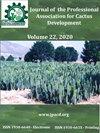Resistance of Opuntia ficus-indica cv ‘Rojo Pelon’ to Dactylopius coccus (Hemiptera: Dactylopiidae) under greenhouse condition
IF 0.4
4区 农林科学
Q4 HORTICULTURE
Journal of the Professional Association for Cactus Development
Pub Date : 2022-11-08
DOI:10.56890/jpacd.v24i.509
引用次数: 3
Abstract
Opuntia ficus-indica (L.) Mill.), is called "beles" in the Tigray region of Ethiopia, where it is used for multiple purposes, such as food, fodder, and fences; however, in recent years the introduction of the cochineal (Dactylopius coccus Costa) to this region has caused it to become a plague that has affected thousands of hectares, causing an economic and social problem. Six cultivars: three from Opuntia ficus-indica (‘Atlixco’, ‘Chicomostoc’, and ‘Rojo Pelón’) and three others O. cochenillifera (‘Nopalea’ and ‘Bioplástico’) and O. robusta (‘Robusta’) were tested for resistance to D. coccus in completely randomized design (CRD) experiment with six replications under greenhouse conditions, for two seasons (cycles). Matured cladodes were infested by attaching a paper bag with ten ovipositing female D. coccus. The number of insects at different stages and yields were recorded, log transformed (insect count data), and subjected to statistical analysis. The number of nymphs (stages I and II) was significantly different in both cycles (P=0.0000). The insects died at the nymph I stage at ‘Rojo Pelón’ and ‘Robusta’, in contrast, they completed their life cycle at ‘Atlixco’, ‘Chicomostoc’, and ‘Nopalea’ cultivars. Insects at ‘Bioplástico’ cultivar remained in the nymph I stage the whole experimental period; the molting was hampered. Although some crawlers started settling (nymph I) at ‘Rojo Pelón’, they couldn’t survive and developed, and this confirms that this O. ficus-indica cultivar is resistant to D. coccus.温室条件下仙人掌(Opuntia ficus indica cv‘Rojo Pelon’)对毒蜥(Dactylopius coccus)的抗性(半翅目:毒蜥科)
仙人掌(Opuntia ficus indica(L.)Mill.),在埃塞俄比亚提格雷地区被称为“贝莱斯”,在那里它被用于多种用途,如食物、饲料和围栏;然而,近年来,胭脂虫(Dactylopius coccus Costa)被引入该地区,导致其成为一种瘟疫,影响了数千公顷的土地,造成了经济和社会问题。在完全随机设计(CRD)实验中,在温室条件下进行了两个季节(周期)的六次重复,测试了六个品种:三个来自仙人掌(“Atlixco”、“Chicomostoc”和“Rojo Pelón”)和另外三个O.cochenillifera(“Nopalea”和“Bioplástico”)和O.robusta(“robusta”)对D.coccus的抗性。用装有10只产卵雌性D.coccus的纸袋对成熟的分支节进行感染。记录不同阶段的昆虫数量和产量,进行对数转换(昆虫计数数据),并进行统计分析。若虫数量(阶段I和阶段II)在两个周期中都有显著差异(P=0.0000)。在若虫I阶段,“Rojo Pelón”和“Robusta”的昆虫死亡,相比之下,它们在“Atlixco”、“Chicomostoc”和“Nopalea”品种完成了生命周期。“Bioplástico”品种的昆虫在整个实验期间都停留在若虫I期;蜕皮受到阻碍。尽管一些爬行类开始在“Rojo Pelón”定居(若虫I),但它们无法生存和发育,这证实了这种O.ficus indica品种对D.coccus具有抗性。
本文章由计算机程序翻译,如有差异,请以英文原文为准。
求助全文
约1分钟内获得全文
求助全文
来源期刊

Journal of the Professional Association for Cactus Development
Agricultural and Biological Sciences-Plant Science
CiteScore
1.10
自引率
33.30%
发文量
10
期刊介绍:
The editors of the Journal of the Professional Association for Cactus Development, are very excited to be a part of the excellent editorial committee and to work together to create the synergism between scientists, growers, legislators, and business people so vital to the development of this industry to serve the people of arid lands.
 求助内容:
求助内容: 应助结果提醒方式:
应助结果提醒方式:


